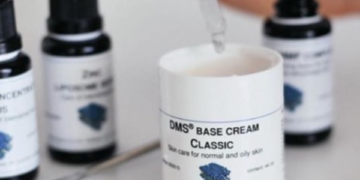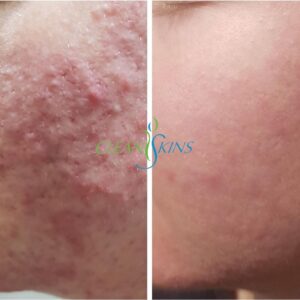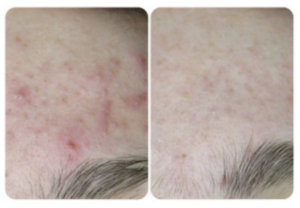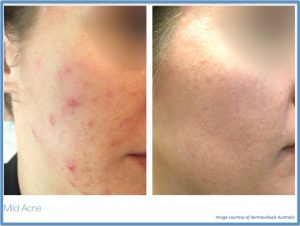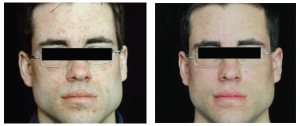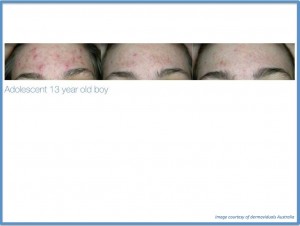CleanSkins Acne Treatment
Acne scarring is one of the hardest skin imperfections to correct. There is no machine, potion or lotion that can remove deep acne scars. Medical intervention may reduce deep acne scars, however most procedures will not remove them completely. The key is prevention. Don’t ignore the acne thinking you will grow out of it.
Acne generally occurs during adolescence, often continuing into young-adulthood, however in today's world adult acne is becoming very prevalent.
70% of successful acne treatment is completed on a daily basis at home utilising a combination of skin care products and lifestyle factors, and only 30% preformed with in clinic treatments. So it is very important that the ingredients in the products used for home care are not going to cause the skin to produce more acne, dry it out, impair the natural moisturising barrier or desensitise the skin. Having some basic knowledge on what cosmetic ingredients to avoid and why, will not only give you better results but also save you money. A common ingredient used in a lot of ‘over the counter’ products for acne treatment is Benzoyl peroxide, which can unnecessarily peel the skin and weaken the natural barrier overtime.


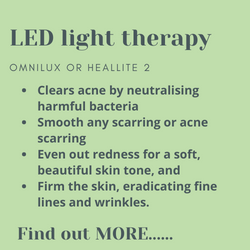


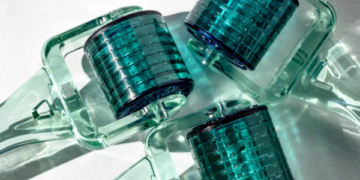
Home Dermal Rolling
Why Have Collagen Induction Therapy (CIT)? CIT or otherwise known as (Skin Needling or Dermal Needling) can assist with; Minimises fine lines …
Read more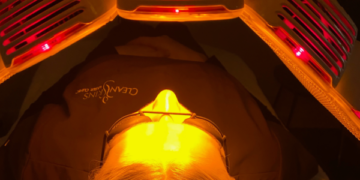
White Light LED
How it works. LED Light therapy is the use of light to stimulate a cellular response within our cells. Cells in the body contain receptors that …
Read more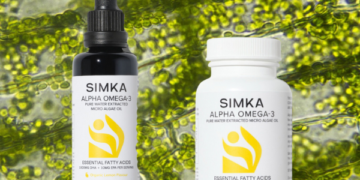
Simka - for Skin
SIMKA is the result of extensive expertise and a desire to create a heritage brand of clean, clinical, consciously formulated skincare. Every …
Read more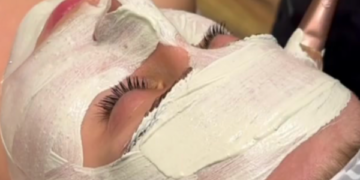
Enzyme Peel
Skin purifying enzymes for gentle removal of redundant skin cells The Enzyme Treatment Mask loosens and removes redundant skin cells (corneocytes). …
Read more
Blue Light LED
How it works. Light therapy is the use of light to stimulate a cellular response within our cells. Cells in the body contain receptors that …
Read more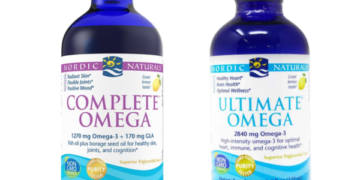
Nordic Naturals Omega's
Why we chose Nordic Naturals Omegas! - because achieving great skin requires a holistic approach! Most problematic skin conditions are not …
Read more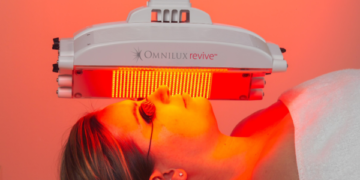
Revive Red Light LED
How it works. LED Light therapy is the use of light to stimulate a cellular response within our cells. Cells in the body contain receptors that …
Read more
Acne Scar Revision Treatment Program
The next step to clear skin! Acne Scars are one of the hardest skin problems to correct, but non impossible. At CleanSkins we work with our …
Read moreAcne Explained
Acne Vulgaris (or acne) is a skin disease that can affect people at one time or another during their lives. Typical types of acne include: seborrheoiac (scaly red skin), comedonal (blackheads and whiteheads), papules (pinheads), pustules (pimples) and nodules (large papules). All acne can result in scarring, however in darker skin scarring can be more prevalent.
Acne most often affects areas of the skin densely populated with sebaceous follicles; including the face, upper part of the chest and back. Severe acne is inflammatory, however acne can also manifest in non-inflammatory forms.
All forms of acne are caused by changes in pilosebaceous units – skin structures consisting of a hair follicle and its associated sebaceous gland.
Acne generally occurs during adolescence, often continuing into young-adulthood. An increase in testosterone (which accrues in both genders during puberty) is the most common cause.
For many people, acne diminishes over time, tending to disappear completely (or at the very least decrease substantially) around our early 20s. However some will experience acne well into their 30’s and 40’s and can in fact develop acne well into adulthood.
Larger nodules are known as cysts whilst the term nodulocystic has been used to describe severe cases of inflammatory acne. Cysts generally appear on the buttocks, groin or armpit area but can occur anywhere that sweat collects in hair follicles and perspiration ducts. Cystic acne affects the deeper layer of skin tissue more profoundly than common acne.
Aside from scarring, the main effects of cysts or nodulocystic acne tend to be psychological and can result in reduced self-esteem and depression. Acne usually appears during adolescence, when teens already tend to be at their most socially insecure. Early and intensive treatment is therefore advocated to lessen the emotional and physical impacts of acne. Topical skin care is only one part of the treatment process.
Effective treatments for acne are very different depending on whether the acne is a dry acne (acne tarda), or a wet/oily acne. All too often people think all acne is produced from oily skin, however, many cases of acne are actually caused by the skin being ‘dried out’. Sadly, this is generally caused by the inappropriate use of cosmetics for the true skin type. When the natural lipidic balance of the skin is out of shape, the skin produces an over-abundance of sebum. Simple mistakes such as this can send the sebaceous glands into overdrive, which can result in acne.

Grades of Acne
Acne is classified into four grades according to severity. Specific criteria are used to classify acne symptoms, including:
- types of non-inflamed comedones present
- types of inflamed comedones present
- amount of breakout activity
- amount of inflammation,
- areas of the body affected by acne
Assessing the grade of acne by a trained skin treatment therapist or dermatologist/ doctor is an important step in treatment, as all acne grades require different treatment methods. Only trained therapists, dermatologists and/or doctors can advise in this regard.
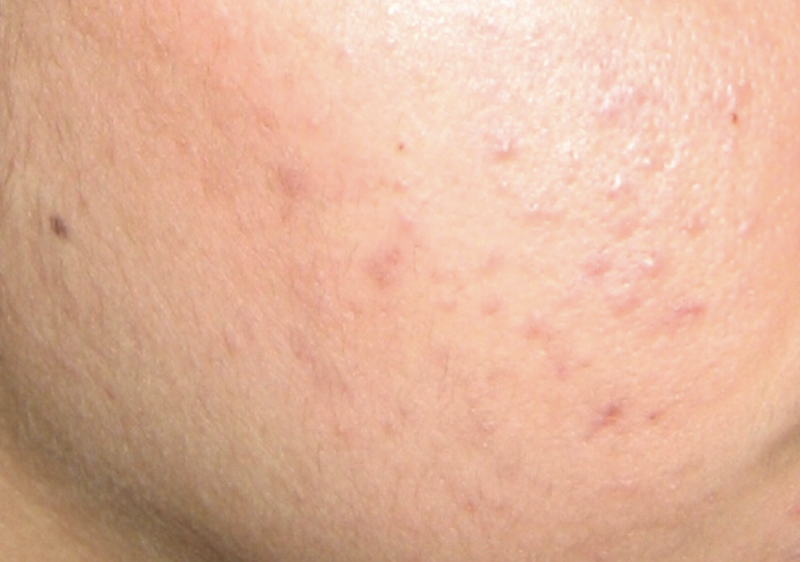
Grade 1
Appearance: The mildest form of acne. There may be minor pimples but they will be small, appear only very occasionally, and in few numbers. Comedones (blackheads) and Milia will be found, sometimes in great numbers, but there is no inflammation present in this grade of acne.
Grade I acne is commonly seen in early adolescence, especially on the nose and/or forehead. Many adults also experience grade I acne, as blackheads on the nose and forehead. Milia are commonly found around the eye area and chin.
Grade I acne may progress to Grade II if left untreated.
Suggested treatment: tailored facial treatments supported by customised skin care designed for your skin type.
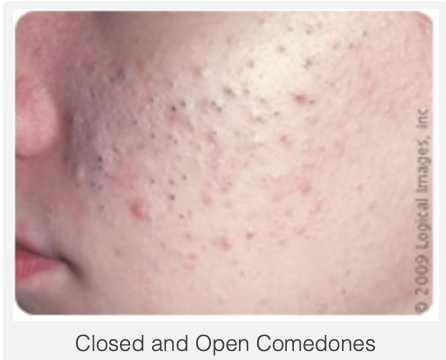
Grade 2
Appearance: Blackheads and Milia exist, generally in greater numbers. Papules and Pustules become more evident in this stage. They will appear with greater frequency, and general breakout activity will be more obvious. Slight inflammation of the skin is now apparent.
In teens, acne may progress from the nose and forehead to other areas of the face. Acne may start to affect the chest and shoulders, with occasional breakouts on the back, especially in males. Adult women may find greater breakout activity on the cheeks, chin and jaw line area, especially just before and during the menstrual cycle.
Grade II acne may progress to Grade III, especially if pimples are habitually picked at or squeezed, as these habits cause the acne to spread.
Suggested treatment: More serious skin treatments with a specialised acne focus will be necessary. Pay careful attention to the ingredients/ types of facials as products and treatments range from potentially harmful Benzoyl Peroxide and other ingredients that can unnecessarily peel the skin, through to the pure and active products found in the in the dermaviduals range. Many ‘over-the-counter’ products contain the ingredient Benzoyl Peroxide. Please carefully consider using these products as research indicates increased sensitivity to sunlight and allergies reactions to it. Whilst these ingredients can lead to short term fixes in the skin, often longer term problems can be created.

Grade 3
Appearance: Considered severe, the main difference between Grade II acne and Grade III is the amount of inflammation present. The skin is now reddened and inflamed. Papules and pustules have developed in greater numbers, and nodules will be present.
Grade III usually involves other body areas, such as the neck, chest, shoulders, and/or upper back and face. The chance of scarring becomes higher as the infection spreads and becomes deeper.
Suggested treatment: Only a qualified dermatologist or specialist skin treatment therapist should treat acne at this stage. Grade III acne is usually treated with both topical and systemic therapies available only by prescription. Left untreated, Grade III acne may progress to Grade IV.
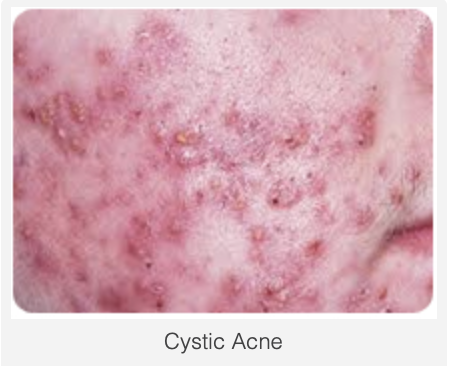
Grade 4
Appearance: This most serious form of acne is referred to as nodulocystic or cystic acne. The skin will display numerous papules, pustules, and nodules, in addition to cysts. There is a pronounced amount of inflammation and breakouts are severe. Cystic acne is very painful.
Acne of this severity usually extends beyond the face, and may affect the entire back, chest, shoulders, and upper arms. The infection is deep and widespread. Nearly all cystic acne sufferers develop scarring.
Suggested treatment: Grade IV acne should be treated by a dermatologist in conjunction with your skin care therapist. It tends to be hard to control, and almost always requires powerful systemic medications in addition to topical treatments.
Aggravating Factors of Acne
- Blocked or compromised follicles
- Comedogenic substances
- Hormones
- Genetic
- Psychological
- Infection
- Diet
Blocked or compromised follicles
Acne develops as a result of blockages in hair follicles. Hyper-keratinisation and the formation of a plug of keratin and an increase in sebum production (a microcomedo so small it is not visible to the naked eye) is the earliest symptom. Enlargement of sebaceous glands and an increase in sebum production also occur with increased androgen (DHEA-S) production at puberty. The microcomedo may enlarge to form an open comedone (blackhead) or closed comedone (milia). Comedones are the direct result of sebaceous glands becoming clogged with sebum, a naturally occurring oil, and the accumulation of dead skin cells. In these conditions, naturally occurring Propionibacterium acnes (P. acnes) can cause inflammation, leading to lesions (papules, infected pustules, or nodules) in the dermis around the microcomedo or comedone, which results in redness and can result in scarring or hyperpigmentation. Comedogenic substances P. acnes are found naturally within our skin and produce a series of fatty acids with potentially comedogenic effects. {Definition: Believed to cause comedones, or pore blockages}. Additional substances that can contribute to acne are mineral oils (oil acne), tar (tar acne), chlorinated hydrocarbons (chloracne), drugs (acne medicamenta) and a multitude of cosmetic substances such as lanolin, cetyl alcohol, saturated fatty acids and their esters. Those with sensitive skin should avoid ingredients such as ethoxilated alcohols and polyethylene glycols (PEG’s) as both are used as emulsifiers and solubilisers. With the influence of ultraviolet rays and atmospheric oxygen they develop peroxides which in turn generate aggressive radicals which can cause Majorca Acne. Given these substances are widely used in many cosmetic products, the skin treatment therapist and educated consumer is advised to carefully study the ingredient list on products before prescribing products to treat acne. Even sun protection products can contain these harmful substances. Ethoxilated alcohols can be recognised on the ingredients listing either by their middle or final syllable (-eth), eg. Ceteareth-10. Please note that no dermaviduals product contains these ingredients. Hormones Hormonal activity, such as menstrual cycles and puberty, may contribute to the formation of acne. During puberty, an increase in male sex hormones called androgens (occuring in both males and females) causes the follicular glands to grow larger and produce more sebum. Use of anabolic steroids may have a similar effect. Several hormones have been linked to the advent of acne in pregnant women and some can lead to disorders such as polycystic ovary syndrome or even the rare Cushing’s Syndrome. Acne associated with menopause occurs as production of the natural anti-acne ovarian hormone Estradiol ceases to be produced at the onset of menopause. The lack of Estradiol can also cause thinning hair, hot flushes, thin skin, wrinkles, vaginal dryness, and can predispose women to osteopenia and osteoporosis, as well as triggering acne (known as Acne Climacterica in this situation). Development of acne vulgaris in later years is uncommon, although this is the age group where Rosacea can occur. Indications of Rosacea are often confused with acne as they can present with similar symptoms. Genetic The tendency to develop acne can run in families. A family history of acne is associated with an earlier occurrence of acne and an increased number of retentional acne lesions. Psychological While the connection between acne and stress continues to be debated, scientific research indicates that “increased acne severity” is “significantly associated with increased stress levels”. The National Institute of Health (USA) lists stress as a factor that “can cause an acne flare.” A study of adolescents in Singapore “observed a statistically significant positive correlation between stress levels and severity of acne.” Adrenal stress stimulates the body to produce cortisol and adrenalin. These hormones trigger changes in the skin, such as increased oil & sebum production. Infection Bacteria in the pores, Propionibacterium acnes (P. acnes) is the anaerobic bacterium that causes acne. Resistance of P. acnes to commonly used antibiotics has been increasing. Diet A high glycemic diet and regular ingestion of cow’s milk have been associated with worsening acne. There is no evidence to suggest that the consumption of chocolate and salt contributes to acne. Look out for these things that can lead to acne.
Potential impacts of Acne
- Scars
- Pigmentation
Scars
Acne scars are the result of inflammation within the dermis. They are created by the wound trying to heal itself, resulting in too much collagen in one area.
Physical acne scars are often referred to as “Icepick” Scars, as they tend to cause an indentation on the skin’s surface. There are a range of treatments available however, one of the leading and proven treatments is is dermal rolling (or skin needling).
- Ice pick scars: deep pits that are the most common and a classic sign of acne scarring.
- Box car scars: angular scars that usually occur on the temple and cheeks, and can be either superficial or deep, these are similar to chickenpox scars.
- Rolling scars: scars that give the skin a wave-like appearance.
- Hypertrophic scars: thickened, or keloid scars.
Pigmentation
Pigmented scarring is a slightly misleading term, as it suggests a change in the skin’s pigmentation, however, this is not the case. Pigmented scars are usually the result of nodular or cystic acne (the painful ‘bumps’ lying under the skin). They often leave behind an inflamed red mark. Often, pigmentation scars can be avoided simply by avoiding aggravation of the nodule or cyst. Pigmentation scars nearly always fade with time taking between three months to two years to do so, although they can last forever if untreated.
Correct skin care and treatments to help Manage symptoms of Acne
Linoleic acid and nutrition – Grade 1 and 2 acne responds well to topical products containing linoleic acid. Liposomes and nanoparticles (cell-like structures which are only visible with electron microscopes) ,are ideal carriers for linoleic acid to reach the skin cells.
Note: professional advice by a qualified expert is important when treating any skin condition. Even products such as hair gels need to be reviewed as traces may be found on the skin. Hair products can be a significant aggravating factor with regard to acne along the hair line.
As sebum production is at its peak during adolescence, many people do not require lipidic substances in their skin care. Alternatively, the lipid content can be reduced with a customized skin care system such as dermaviduals. Lipids are traditionally stabilised in water with emulsifiers which have comedogenic potential. Dermaviduals adopts ground breaking technology to be able to produce emulsifier free products, hence eliminating a major comedegenic factor.
Water-dispersed (liquid) nanoparticles may contain alpha or gamma-linolenic acid in the form of natural oils that are not only effective against cornification disorders but also have anti-inflammatory properties ( refer to dermaviduals evening primrose oil and liposome concentrate plus). The carrier substance is natural phosphatidylcholine, which has sebum reducing and hence anti-comedogenic effects on oily skin due to its high content of linoleic acid. An interesting approach for male adolescents is treatment with phytohormones gained from soybean or red clover which have lightly estrogenic effects. The liposome shell dissolves on the skin barrier and releases linoleic acid in addition to the phytohormones.
The use of LED 417nm combined with 833nm and 630nm will speed the recovery and general health of the skin.
Corneotherapy and Acne
All forms of acne (and their underlying causes) can be treated using a variety of dermaviduals unique active agents. Including:
- sebum-liquefying products: Enzyme treatments in clinic and Liposome Concentrate Plus, Liposome concentrate and Lotion P.
- sebum-suppressive products: Liposome Concentrate Plus, Phytohormorne, Green Tea Extract and Plutio Derm.
- keratosis-impeeding products: Liposome Concentrate Plus, Cleansing Gel and Lotion P.
- anti-microbial products: Plutio Derm, Laminaria Digitata
- anti-inflammatory products: Evening Primrose, Liposome Concentrate Plus , Liposome NMF, Boswellia, Linseed Oil
- immune-suppressive and regenerating effect products:Liposome Yeast, D-Panthenol and Phytohormone.
Frequently the active agents have simultaneous effects. For example, phosphatidylcholine mentioned above has sebum-liquefying, keratosis-preventive, lightly sebum-suppressive and regenerating effects.
Locally applied antibiotics such as Erythromycin or Tetracycline can be used where inflammation is present and they are known to impede the growth of P. acnes bacteria. A hormone treatment for women with progesterone causes sebum suppression. Pay attention to the appropriate composition of base creams and cosmetic products used in order to avoid counterproductive effects, such as mineral oils, fragrances and emulsifiers which may impede the healing process. dermaviduals DMS bases are applied in skin treatment preparations as their composition and structures are similar to the skin (DMS = Derma Membrane Structure). A series of pharmaceutical grade active agents are then added to the base cream, enabling you to obtain a customized treatment to your specific skin condition. A careful cleansing of acne-affected areas is important and dermaviduals enzyme treatments may be very helpful in this respect as they facilitate the opening of the follicles. A light massage in combination with an Enzyme Treatment will support the removal of congestion in the sebaceous glands.
Acne can be difficult to diagnose due to the varying cause and effect of the condition. Hence a thorough skin consultation with a specialist skin treatment therapist such as your dermaviduals stockist is recommended.
Further reading:
References:
Dermaviduals Australasia
Dr Hans. Lautenschläger, various publications Beauty Forum & Cosmetic Medicine
Dr Lance Setterfield; Concise Guide to Dermal Rolling, 2011
Florence Barrett-Hill; Skin Treatment Therapy for the Medical/ Therapeutic Professional, 2008
Wikipedia acne.about.com

